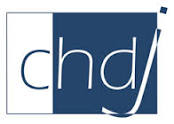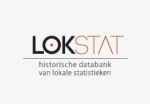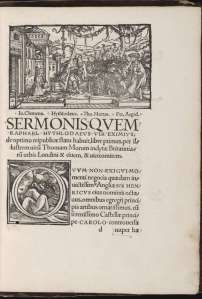
Broadside “John Bull, can you wonder at crime?”, ca. 1860 – image The Lawbook Exchange Ltd. (no. 11 in the catalog)
It is the happy liberty of any blogger to choose themes and subjects at will, but sometimes they advert themselves readily. The last years I have written a few times about recent catalogs of antiquarian booksellers. In this post I would like to look at a catalog concerning thirty American and British broadsides. Broadsides and pamphlets, including even broadside ballads, have figured here on several occasions. It led me eventually to creating an overview of digital pamphlet collections at my website. This time I will also discuss a matter which is very visible but not always seen in its full implications. Every item in the catalog is offered for a prize which is closely linked with its rarity. Which criteria are commonly used? Is it possible to establish more about the presence of rare books in the collections of libraries and other institutions? Where is the line between a general approach and more detailed procedures? Some roads may be well known, others might not be as obvious as you tend to assume.
Thirty broadsides
Last week the Lawbook Exchange Ltd., a well-known firm from Clark, New Jersey, alerted to a new catalog figuring thirty American and British broadsides, and also one French item. You can view the catalog online or download a PDF version (2,4 MB). You can change the order of the items in eight ways, depending on your wish to see them in alphabetical or chronological order of the titles or the authors, or perhaps starting with the highest prize. The highest prize in this catalog is for the broadside A brief account of the execution of six militia men!!, published in 1828 in the campaign against Andrew Jackson. The catalog refers to a bibliography by Shaw and Shoemaker who did not record this publication.
The second highest prize is for a British broadside published around 1850 with a satirical attack on lawyers, Beware Important Caution Beware of a Pair of Bipeds (…), a broadside which looks like an official notification. The staff of The Lawbook Exchange states they were unable to find any copy of this broadside Let’s not forget to mention at least the only French broadside of the catalog, an arrêt of the Conseil du Roi concerning merchants published at Aix-en-Provence in 1765. The catalog comments that the survival of this notice meant to be posted at market places is remarkable, and adds “No copies located on OCLC”.

I could have taken you here on a tour through a number of broadsides concerning trials, but somehow the notices about the rarity of the items caught my eyes and kept resonating. The simplest thing to note is that OCLC is the firm behind WorldCat, by no means the only product of this firm. WorldCat is a meta-catalog harvesting its results directly from a vast number of library catalogs all over the world. In this respect it differs from the Karlsruher Virtueller Katalog (KVK) which uses mainly national and regional union catalogs which may lag behind in the actual state of library holdings. One of the reasons to look beyond WorldCat is the fact some rather large libraries have not yet joined WorldCat. Utrecht University Library, not the smallest Dutch library, will join only in August this year, yet another thing that made me reflect.
The KVK gives you access to German and Swiss regional catalogs. It dawned on me regional catalogs in other countries might well exist, even if they are not or not yet accessible using the KVK. At first I did not readily find a single resource for national union catalogues and regional catalogs. I cannot hide the fact the Dutch union catalog, the Nederlandse Centrale Catalogus, is only accessible at subscribing libraries and for their cardholders. A second Dutch union catalog, the Catalogus Plusbibliotheken (WSF), leads you in open access to the holdings of fourteen Dutch research libraries. For Belgium I could quickly trace Antilope, a city union catalog for Antwerp, and Cageweb, a meta-catalog for the libraries of Ghent University, two valuable resources which supplement UniCat, the union catalog of Belgian university libraries.
The KVK does indeed include all German regional catalogues. Some of the five regional catalogues – GBV, KOBV, HEBIS, SWB and BVB – cover libraries in several Bundesländer, a thing which clearly escaped me. For a number of smaller regions and some cities there are smaller sets taken from a main regional catalog. Instead of guiding you to them you might benefit also from two other German union catalogues for a particular kind of libraries, the Kirchlicher Verbundkatalog and the Virtueller Katalog Theologie und Kirche, an offspring of the KVK.
A gateway to gateways and catalogs

I did not find a good overview of relevant catalogs until I realized I had searched with a focus on meta-catalogs. Using the term (national) union catalog proved to be crucial. I finally arrived at ShareILL with among its finding aids and tools its impressive list of gateways and union catalogs. The list thoughtfully refers also to a number of union catalogs for serials, but the most important thing is the inclusion of a number of regional catalogs, making me curious about more examples. Let’s stick here with British and American libraries, but it is of course possible to mention other interesting regional catalogs. For 25 libraries in London and the surrounding area you can benefit from Search25. The Serials Union Catalogue (SUNCAT) has a useful overview of comparable projects and union catalogs. Alas some links seem to be broken, but you can for example use the UK Union Catalogue of Chinese books hosted at the Bodleian Libraries, Oxford. Valuable are also the references to projects for a survey of special collections, MASC25 for the London area, hosted at University College London, and RASCAL for special collections in Ireland. The SCORE project for searching printed British company reports survives in an archived version created by the National Archives.
The list at ShareILL for the United States looks rather short, but it includes the vast overview of Z39.50 compliant libraries created by the Library of Congress. The overview deal also with union catalogs in other countries, and although it indicates regional catalogs these are almost only public libraries. The Library of Congress provides a special Z39.50 entrance to these catalogs, for example for the Five Colleges (Amherst, Hampshire, Mount Holyoke, Smith and UMass Amherst). The overview does mention Melvyl, the central catalog of the university libraries within the University of California, nowadays fully searchable at a subdomain of WorldCat. I was aware of the CARLI regional catalog for research libraries in Illinois, but at first I found only a few other examples, the JerseyCat for New Jersey and the WRLC Catalog of the Washington Research Libraries Consortium. At LibWeb, the most extensive survey of libraries worldwide, you can easily find regional library consortia in the United States, but only seldom you will encounter research libraries in the very names of projects. I am sure there is more than meets the eye! For the purpose of this post I must mention at least New York Heritage, a portal to digitized collections in the state New York, and the digital collections of the New York Public Library. The NYPL refers to digitized versions in licensed collections of copies of two other editions of the 1828 anti-Andrew Jackson pamphlet (Shoemaker no. 32473). An overview of union catalogs for states in the United States can be found at the website accompanying Godfrey Oswald’s Library World Records (3rd ed., 2017), and he gives even more overviews of union catalogs elsewhere in the world.
In my view it makes sense to refer to specific libraries or even to digital collections when you deal with specific items. For no. 26, a broadside from 1783 announcing a tax in Massachusetts, the staff of The Lawbook Exchange rightly point to a bibliography of early Massachusetts imprints, but they could have referred also to libraries such as Harvard University Library, the Boston Public Library, the library of Boston College, the Boston Athenaeum or the Massachusetts Historical Society. For Confederate imprints pointing to the Boston Athenaeum is surely advisable, because there is for these imprints both a digital collection and a digitized bibliography.
The road of bibliographies
Mentioning Shoemaker brings me to bibliographies of a particular kind. Specialized bibliographies, both in print and online, are a second resource to gain information about books concerning a particular period, author, subject, publisher or publications from a particular town or country. In the case of Shaw and Shoemaker we need to distinguish between the printed bibliographies by Ralph R. Shaw and Richard H. Shoemaker, American bibliography; a preliminary checklist for 1801-1819 (New York, 1958) and the multi-volume publication A checklist of American imprints 1820-1829 (10 vol., New York, 1964-1973). The licensed online version by the firm Readex abbreviated as Shaw-Shoemaker has as its full title Early American Imprints II; Shaw-Shoemaker 1801-1819, with some 36,000 imprints. For a book or pamphlet printed in 1828 the references in the catalog with thirty broadsides are to the printed edition.
If you look closely at the items in the catalog with thirty broadsides you will notice not every description contains references to online catalogs and relevant bibliographies. For no. 1, $50.00 Reward! The Above Reward will be Paid for the Recovery the [sic] Body of Miss Jennie Warren (…), a broadside from Illinois printed in 1875, we read it is an unrecorded broadside, without indicating which resources have been used. In this case you might conclude thus when you do not find this broadside in the CARLI union catalog for Illinois, the Library of Congress, the KVK, and perhaps as an addition the general catalog of the American Antiquarian Society. Thanks to an initiative of the University of Michigan you can perform full text searches in the digitized version of the National Union Catalog Pre-1956 imprints in the Hathi Trust Digital Library, searching the title of this particular broadside in the online version is challenging. To me it seems more convincing to indicate where you sought without any result than to state merely something is unrecorded.
I would feel perfectly happy when for example the 1836 ordinance on market law in Albany (no. 2) was not found in the New York State Library in Albany, the New York State Archives and the New York Public Library. There is a union catalog for libraries in New York, ConnectNY. No. 4, a broadside about the trial and execution of Henry Anderson in 1822, presented as an item unrecorded in WorldCat and the British COPAC, can nevertheless be found in WorldCat with even a link to a digitized version in Harvard University’s crime broadsides project. The point for me is not to point to any fault or omission, but to underline the need for a consistent approach. For no. 21, Ein neues Lied von der Mord-Geschichte des Joseph Miller (…) (s.l., s.n., [1822]) the bibliographical information is very substantial. Hermann Wellenreuther counted in Citizens in a Strange Land A Study of German-American Broadsides and Their Meaning for Germans in North America, 1730–1830 (University Park, PA, 2013) sixteen editions of this text. It seems this is indeed an unrecorded copy of a most rare edition. PennState University Libraries have created a digital collection with some 1,890 items for these German broadsides which were especially published in Pennsylvania.
Broadsides in digital collections

Trial pamphlets and broadsides have been lucky in digitization projects. My interest in the thirty broadsides of this catalog is also linked with my general interest in digitized pamphlets and broadsides. A few years ago I started with a page on my legal history website for digital collections in this particular field. Apart from the collection mentioned above at Harvard Law School I have checked for the presence of the broadsides under discussion also in the Trial Pamphlets Collection of Cornell University Library. You will spot in my overview at least fifteen digitized collections with broadsides in the United States. In the United Kingdom only a few collections deal explicitly and exclusively with broadsides. On the other hand broadside ballads are rightly regarded as a distinct subgenre, and I have recorded digital collections dealing with them. You might want to read my 2017 post about broadside ballads.
In December 2017 a three-year cataloging project at Het Utrechts Archief ended for some 5,000 Early Modern municipal and provincial ordinances. Archives are the place where you can expect ordinances which have sometimes been published both as pamphlets and as broadsides. In a splendid volume with scholarly articles about Early Modern broadsides, Broadsheets. Single-sheet publishing in the first age of print (Leiden 2017), edited by Andrew Pettegree, the presence of broadsides in archives is a subject which Pettegree rightly mentions in the introductory chapter. Broadsides have not always received the attention they deserve. Their ephemeral nature has been taken for granted. Some of the leading bibliographical projects for Early Modern books even excluded broadsides, among them the Short Title Catalogue Netherlands (STCN) and the Short Title Catalogue Vlaanderen (STCV). However, the STCV has now started to include Flemish broadsides as well, and even gives them a paragraph in the cataloging manual. Pettegree notes Anton van der Lem has entered sixteenth-century broadsides for the STCN. The introduction by Pettegree is a must-read for anyone interested in broadsides. For Italy Pettegree mentions projects and books concerning governmental publications printed as broadsides. In a post two years ago I could even point to digital collections with Italian Early Modern bandi from Rome, Bologna and Venice. What holds true for Early Modern editions can to a large extent be extended to later editions.
Multiple roads to go
At the end of this rather long post I guess we just touched the surface of a subject deserving detailed attention. Is it possible to give a concise rule for indicating facts about the uniqueness or common presence of old books, prints and broadsides? WorldCat contains information from more libraries than any other resource, but I find it often cumbersome to find in WorldCat which library contributed the information about a specific item. The KVK is strong for European collections and does harvest apart from national union catalogs a number of regional catalogs. We have seen it is possible and feasible to use these regional library catalogs whenever this is sensible. Sometimes you will point to a few libraries where you expect items to be, such as the Library of Congress, major national and university libraries. Legal historians will think of the holdings of the Max-Planck-Institute for European Legal History in Frankfurt am Main. The Vatican Library is of course another institution with very rich holdings. Specialized bibliographies help very much to gain deeper insight.
In the face of an increasingly international public it makes sense to enlarge the references to them in order to prevent an impression of sharing arcane information with the happy few who are nourri dans le sérail. I would prefer putting the references in a separate paragraph of the description of an item in a book seller’s catalog. By looking also at archives and their collections you can do justice to the fact broadsides are different from books. In archives you might find more broadsides than you expect. Awareness of both archival collections in libraries and of books and broadsides in the holdings of archives broadens your view and can be most helpful. How to achieve this? Scholars, librarians, archivists and antiquarian booksellers need each other and the services they can provide.
To sum up, mention where you searched for information, thus honouring the principle of responsible incompleteness, use both WorldCat and the KVK, remember also to use the catalogs of libraries and archives nearby, or look at specific libraries, and use relevant printed and online bibliographies. Any time you can add something important from your own knowledge and experience you should feel free to put it into action! In an increasingly virtual world it is good to remember you will find these bibliographies – and access to licensed online resources – in research libraries. As users we should wake up when we read words like rare and unique, but let’s not blame a book seller for wanting to create an interest in his goods.
The Lawbook Exchange Ltd., Clark, NJ: 30 Broadsides, May 8, 2018





























